
Vertebrate paleontology is the subfield of paleontology that seeks to discover, through the study of fossilized remains, the behavior, reproduction and appearance of extinct animals with vertebrae or a notochord. It also tries to connect, by using the evolutionary timeline, the animals of the past and their modern-day relatives.
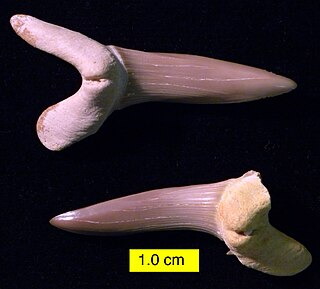
Scapanorhynchus is an extinct genus of shark that lived from the early Cretaceous until possibly the Miocene if S. subulatus is a mitsukurinid and not a sand shark. Their extreme similarities to the living goblin shark, Mitsukurina owstoni, lead some experts to consider reclassifying it as Scapanorhynchus owstoni. However, most shark specialists regard the goblin shark to be distinct enough from its prehistoric relatives to merit placement in its own genus.

The Nemegt Formation is a geological formation in the Gobi Desert of Mongolia, dating to the Late Cretaceous. The formation consists of river channel sediments and contains fossils of fish, turtles, crocodilians, and a diverse fauna of dinosaurs, including birds.
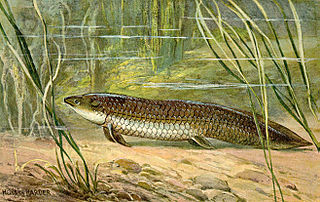
Ceratodus was a wide-ranging genus of extinct lungfish. Fossil evidence dates back to the Early Triassic. A wide range of fossil species from different time periods have been found around the world in places such as the United States, Argentina, Greenland, England, Germany, Egypt, Madagascar, China, and Australia. Ceratodus is believed to have become extinct sometime around the beginning of the Eocene Epoch. The closest living relative of Ceratodus is thought to be the Queensland lungfish, Neoceratodus forsteri, which means "new Ceratodus" in Greek.

Tusoteuthis is a dubious extinct genus of large enchoteuthine cephalopod that lived during the Cretaceous. Although often called a squid, it is now thought to be more closely related to modern octopuses. Examination of gladius remains has yielded an estimated mantle length close to or equal to that of the modern giant squid. Fossil remains have been found in parts of the one-time Western Interior Seaway of North America, including Late Cretaceous rocks in Kansas, Colorado, Wyoming, South Dakota, North Dakota, and Manitoba Province. One species, T. longa, is traditionally recognized.

Ichthyodectiformes is an extinct order of marine stem-teleost ray-finned fish. The order is named after the genus Ichthyodectes, established by Edward Drinker Cope in 1870. Ichthyodectiforms are usually considered to be some of the closest relatives of the teleost crown group.
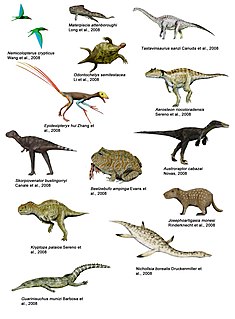
Paleontology or palaeontology is the study of prehistoric life forms on Earth through the examination of plant and animal fossils. This includes the study of body fossils, tracks (ichnites), burrows, cast-off parts, fossilised feces (coprolites), palynomorphs and chemical residues. Because humans have encountered fossils for millennia, paleontology has a long history both before and after becoming formalized as a science. This article records significant discoveries and events related to paleontology that occurred or were published in the year 2008.

Axelrodichthys is an extinct genus of mawsoniid coelacanth from the Cretaceous of Africa, North and South America, and Europe. Several species are known, the remains of which were discovered in the Lower Cretaceous (Aptian-Albian) of Brazil, North Africa, and possibly Mexico, as well as in the Upper Cretaceous of Morocco (Cenomanian), Madagascar and France. The Axelrodichthys of the Lower Cretaceous frequented both brackish and coastal marine waters while the most recent species lived exclusively in fresh waters. The French specimens are the last known fresh water coelacanths. Most of the species of this genus reached 1 metre to 2 metres in length. Axelrodichthys was named in 1986 by John G. Maisey in honor of the American ichthyologist Herbert R. Axelrod.
Acanthomorpha is an extraordinarily diverse taxon of teleost fishes with spiny-rays. The clade contains about one third of the world's modern species of vertebrates: over 14,000 species.

Bananogmius is an extinct genus of ray-finned fish that lived in what is today Kansas during the Late Cretaceous. It lived in the Western Interior Seaway, which split North America in two during the Late Cretaceous.

Mawsonia is an extinct genus of prehistoric coelacanth fish, and the largest of this group, ranging from an estimated 3.5 metres up to 6.3 metres long. It lived during the latest Jurassic to Cretaceous periods of South America, eastern North America, and Africa. Mawsonia was first described by British paleontologist Arthur Smith Woodward in 1907.

The Kem Kem Group is a geological group in the Kem Kem region of eastern Morocco, whose strata date back to the Cenomanian stage of the Late Cretaceous. Its strata are subdivided into two geological formations, the lower Gara Sbaa Formation and the upper Douira Formation. It is exposed on an escarpment along the Algeria–Morocco border.

Paranogmius is an extinct genus of prehistoric bony fish that lived during the Cenomanian. It is known from a single vertebra discovered in the Bahariya Formation. The bone was destroyed during World War II and since then, no more fossils have been discovered. It may have been up to 4 metres (13 ft) long when fully grown, although this is just a very rough estimate.

Ptychoceratodus is an extinct genus of prehistoric sarcopterygians or lobe-finned fish originally named as a species of Ceratodus in 1837. It was a lungfish from the Mesozoic era (Triassic-Cretaceous), and the only members of the family Ptychoceratodontidae. One species, P. oldhami, was named in 2018 based on remains from the Carnian-aged Tiki Formation (India). The first named species, which is also the type species, is P. phillipsi, which was named in 1837 by Louis Agassiz as a species of Ceratodus and moved to a separate genus in 1926.
Psilichthys is an extinct genus of prehistoric bony fish from the Lower Cretaceous epoch of what is now Victoria, Australia. It has previously been referred to the family Birgeriidae; however it was removed from this family due to differences with Birgeria.
Chuhsiungichthys is an extinct genus of ichthyodectiform ray-finned fish that lived in freshwater environments in what is now Yunnan, China, and Kyushu, Japan, during the Cretaceous. It differs from its sister genus, Mesoclupea, primarily by having a comparatively more anteriorly-placed dorsal fin.
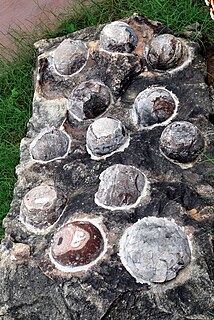
Egg fossils are the fossilized remains of eggs laid by ancient animals. As evidence of the physiological processes of an animal, egg fossils are considered a type of trace fossil. Under rare circumstances a fossil egg may preserve the remains of the once-developing embryo inside, in which case it also contains body fossils. A wide variety of different animal groups laid eggs that are now preserved in the fossil record beginning in the Paleozoic. Examples include invertebrates like ammonoids as well as vertebrates like fishes, possible amphibians, and reptiles. The latter group includes the many dinosaur eggs that have been recovered from Mesozoic strata. Since the organism responsible for laying any given egg fossil is frequently unknown, scientists classify eggs using a parallel system of taxonomy separate from but modeled after the Linnaean system. This "parataxonomy" is called veterovata.
Melvius is a genus of vidalamiin amiid fish from the Late Cretaceous. The type species, Melvius thomasi, was described by Bryant in 1987. A second species Melvius chauliodous, was named and described by Hall and Wolburg in 1989, and it is now considered to be one of the index taxa of the Kirtlandian land-vertebrate age.
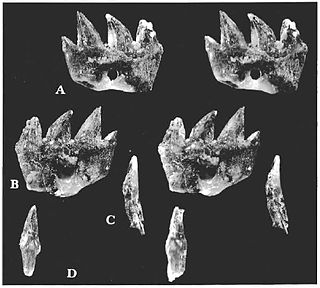
Ichthyoconodon is an extinct genus of eutriconodont mammal from the Lower Cretaceous of Morocco. It is notable for having been found in a unique marine location, and the shape of its teeth suggests an unusual, potentially fish-eating ecological niche. Analysis suggests it is part of a group of gliding mammals that includes Volaticotherium.
Concavotectum is an extinct genus of tselfatiiforme bony fish that lived during the Cenomanian in Morocco and possibly Egypt. It was discovered and named in 2008 and is known from a single well preserved hand-sized skull and a few isolated vertebrae discovered in the Kem Kem Group. The type species, C. moroccensis, was named in 2008 and described in 2010. A possible second specimen, found in the Baharija Formation, consists of a single vertebra, which was destroyed in 1940 during World War II. It is currently the holotype of the possible synonym Paranogmius.
















